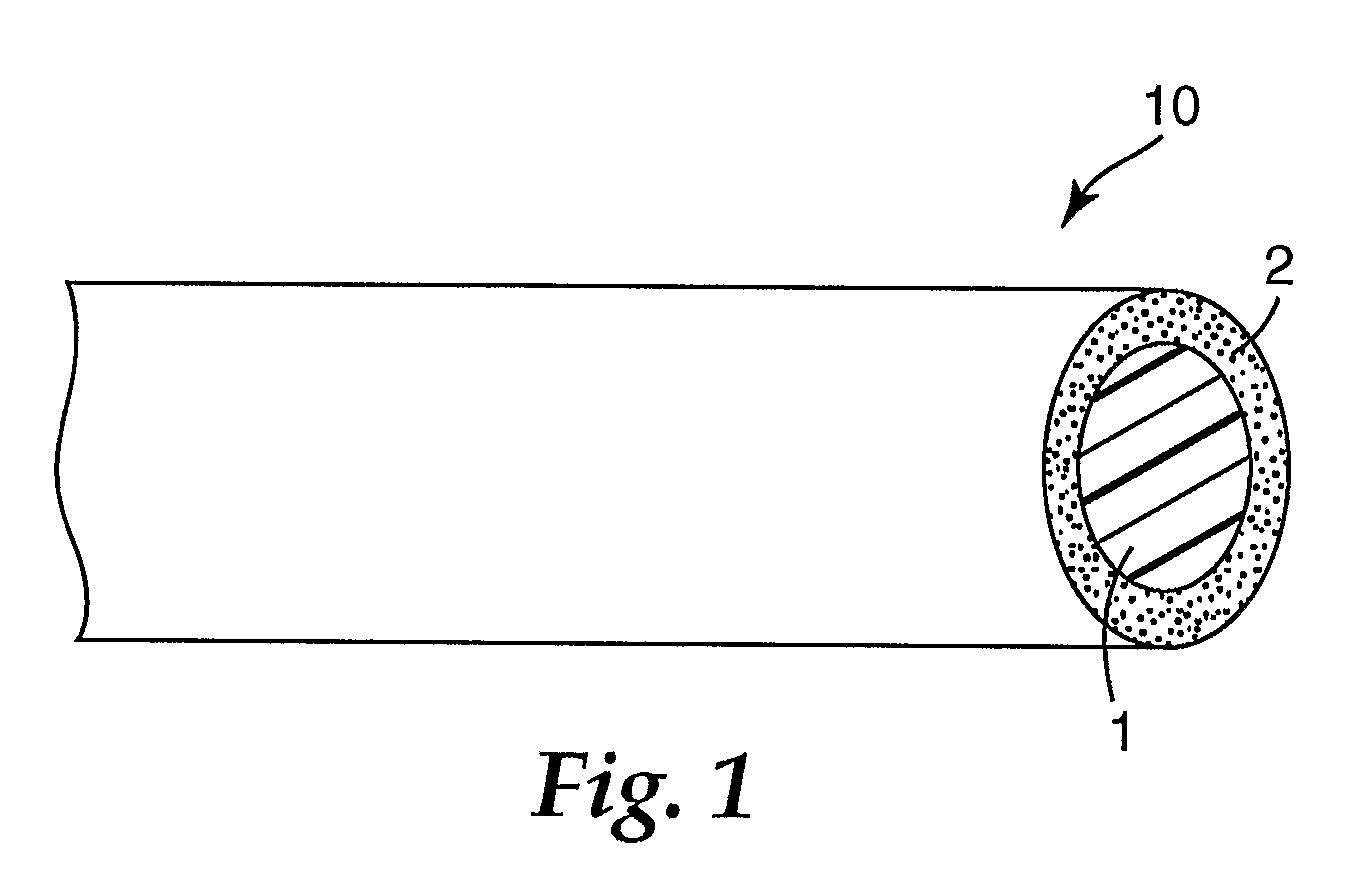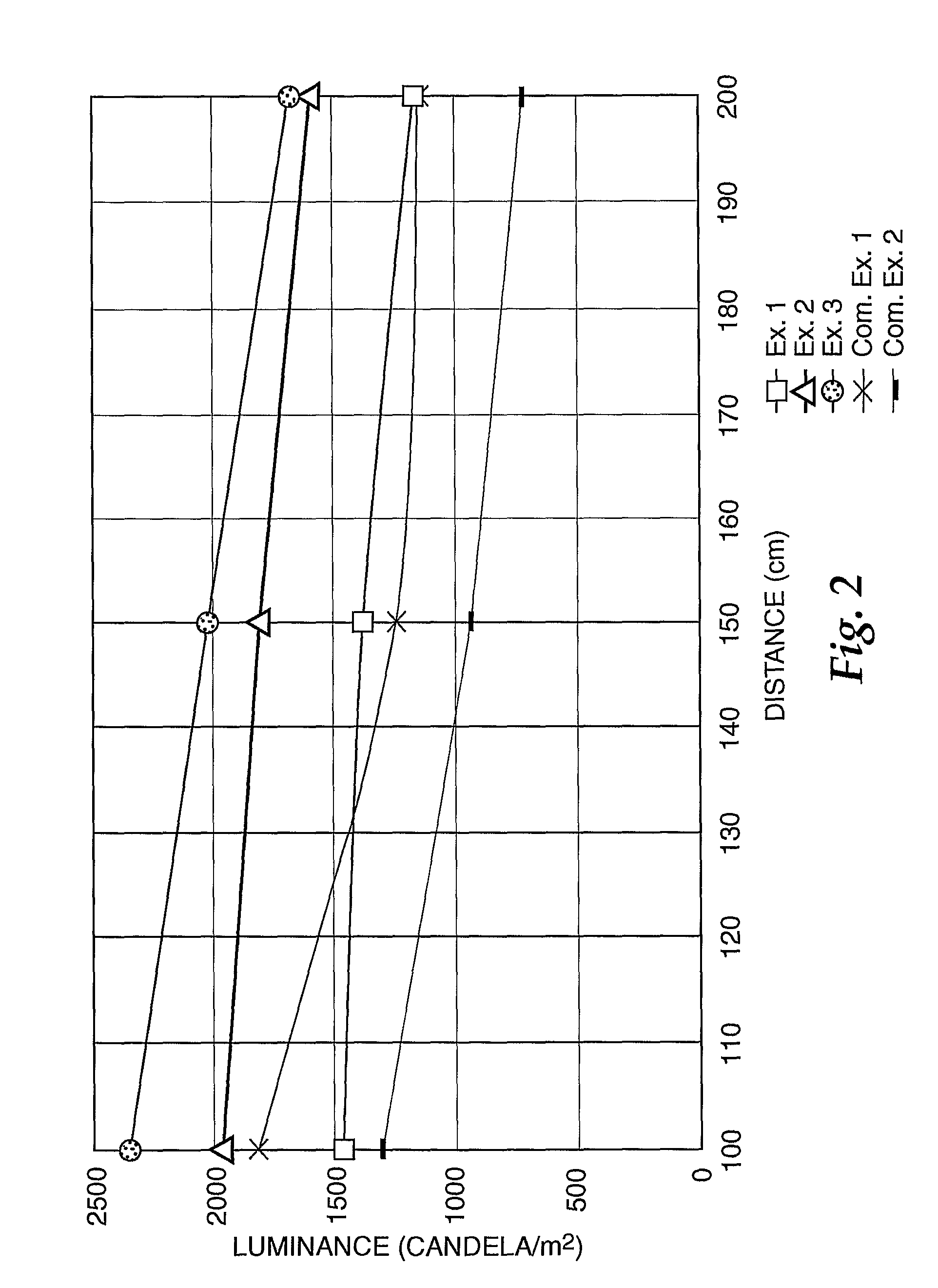Lateral Emitting Optical Fiber and Light Emitting Device
a technology of optical fiber and light emitting device, which is applied in the field of optical fiber, can solve the problems of low light transmittance, inability to emit light in a wide visual angle, scattered light which has reached the core-clad boundary, etc., and achieves the effects of reducing ultraviolet transmittance, increasing uniformity of luminance, and reducing ultraviolet transmittan
- Summary
- Abstract
- Description
- Claims
- Application Information
AI Technical Summary
Benefits of technology
Problems solved by technology
Method used
Image
Examples
example 1
[0043]FEP100J (trade name) (DuPont) was loaded into a first extruder, and then FEP resin comprising zinc oxide particles (particle size=0.5 μm) dispersed therein at 29 wt % was loaded into a second extruder at 5.56 parts by weight with respect to 100 parts by weight of FEP100J (trade name). The resins were coextruded through a prescribed die, to obtain a tube-shaped double-layered clad material with an outer diameter of about 13 mm, comprising a light-transmitting resin layer with a thickness of about 317 μm as an outer layer and a light-dispersing resin layer with a thickness of about 138 μm as an inner layer.
[0044]For formation of the core material, 4 parts by weight of hydroxyethyl methacrylate, 96 parts by weight of n-butyl methacrylate and 1 part by weight of triethyleneglycol dimethacrylate were combined to prepare a monomer mixture. Next, 1.0 part by weight of lauroyl peroxide was added to the mixture as a thermal polymerization initiator to prepare a core precursor.
[0045]Aft...
example 2
[0047]Two extruders including a first extruder and second extruder were prepared, and FEP100J (trade name) (DuPont) was loaded into the first extruder and FEP resin having zinc oxide particles (particle size=0.5 μm) dispersed therein at 29 wt % was loaded into the second extruder at 5.56 parts by weight with respect to 100 parts by weight of FEP100J (trade name). The resins were coextruded through a prescribed die, to obtain a tube-shaped double-layered clad material with an outer diameter of about 13 mm, comprising a light-transmitting resin layer with a thickness of about 244 μm as an outer layer and a light-dispersing resin layer with a thickness of about 256 μm as an inner layer. An optical fiber was fabricated in the same manner as Example 1 except for using this clad material. The final outer diameter of the optical fiber was 13.7 mm, and the clad material thickness was 0.5 mm.
[0048]The 256 μm inner layer portion of the clad material contained zinc oxide particles at 1.53 wt %...
example 3
[0049]Two extruders including a first extruder and second extruder were prepared, and a mixture of 12.5 parts by weight of FEP resin having zinc oxide particles (particle size=0.5 μm) dispersed therein at 29 wt % combined with respect to 100 parts by weight of FEP100J (trade name) was loaded into the first extruder. Also, a mixture of 5.56 parts by weight of FEP resin having zinc oxide particles (particle size=0.5 μm) dispersed therein at 29 wt % combined with respect to 100 parts by weight of FEP100J (trade name) was loaded into the second extruder. The resins were coextruded through a prescribed die, to obtain a tube-shaped double-layered clad material with an outer diameter of about 13 mm, comprising a light-transmitting resin layer with a thickness of about 19 μm as an outer layer and a light-dispersing resin layer with a thickness of about 481 μm as an inner layer. An optical fiber was fabricated in the same manner as Example 1 except for using this clad material. The final out...
PUM
| Property | Measurement | Unit |
|---|---|---|
| particle sizes | aaaaa | aaaaa |
| particle size | aaaaa | aaaaa |
| refractive index | aaaaa | aaaaa |
Abstract
Description
Claims
Application Information
 Login to View More
Login to View More - R&D
- Intellectual Property
- Life Sciences
- Materials
- Tech Scout
- Unparalleled Data Quality
- Higher Quality Content
- 60% Fewer Hallucinations
Browse by: Latest US Patents, China's latest patents, Technical Efficacy Thesaurus, Application Domain, Technology Topic, Popular Technical Reports.
© 2025 PatSnap. All rights reserved.Legal|Privacy policy|Modern Slavery Act Transparency Statement|Sitemap|About US| Contact US: help@patsnap.com



